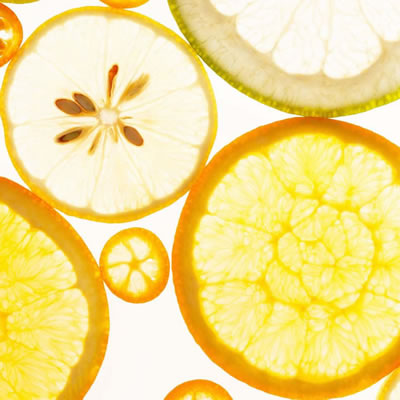Acids
What are Acids?
Acids are substances that can neutralize alkalis to form salts. When dissolved in water, they release protons (hydrogen ions), reducing the pH and driving it lower than the neutral point of 7.1
They perform a variety of functions in foods and bake systems including acidification, buffering, preservation, gel setting, flavor development, leavening and many others. There are two classes:
- Organic acids: referred to as weak acids which are composed of carbon, hydrogen and oxygen such as citric, ascorbic, lactic, malic, tartaric, and fumaric.
- Inorganic acids: referred to as strong acids which contain minerals and include phosphoric, hydrochloric, and sulfuric acids.
Origin
Acids are abundant in nature with organic acids being the most common in food applications. Commercially, many are produced by microbes and fermentation processes. Citric acid, for example, is naturally present in citrus and other fruits but is produced on large-scale from Aspergillus niger.2 Tartaric acid is derived from wine by-products but is commercially prepared from xylose using racemic resolution processes. Inorganic varieties such as phosphoric, sulfuric and hydrochloric are produced using chemical processes.
Function
In baked goods, they serve several purposes, such as:
- Preservation and shelf life extension: In many bakery products, acids help in extending the finished product’s shelf life by lowering pH. Moreover, under those conditions preservatives such as calcium propionate and potassium sorbate are in their most active form. Fermentation-based reactions using cultured wheat flour/starch/dextrose can produce organic acids of powerful antimicrobial activities.
- Chemical leavening: typically, organic acids react with sodium bicarbonate or other alkalis to produce carbon dioxide gas, essential for volume building in cakes, biscuits and many bakery products according to the following reaction:
HX + NaHCO3 → NaX + H2O + CO2
HX: non-metal leavening acid3
- Flavor enhancement and balancing: organic acids, as acidulants, can add desirable sour notes, sharpen taste and/or balance flavors and sweetness in products like sourdough breads, raisin bread, artisan breads/bread mixes, turnovers, or pastries. Traditionally, sour milk products, lemon juice, and fruit products are acid sources used for that purpose.
Nutrition
Organic acids play a significant role in intracellular metabolic pathways such as catabolism of amino acids, the tricarboxylic acid cycle (TCA) as well as various neurotransmitter functions.
Commercial production
Organic acids can be obtained using various processes, mainly:
- Chemical oxidation of aldehydes under controlled parameters to form carboxylic acids.
- Biotechnological process: Vinegar and citric acid, for example, are commercially obtained by fermentation. Acetobacter aceti converts ethanol to acetic acid under aerobic conditions.
Application4,5
Typical applications and neutralization values (NV*) of organic acids in various baked products are listed in the following table:
| Acid | Chemical formula | Role in baked goods | NV* |
| Citric | C6H8O7 | Flavoring agent or acidulant
Its salts are used sourdough bread to provide distinct flavors |
87 |
| Fumaric | C4H4O4 | An acidulant and effective leavening acid (less acid is needed to react with sodium bicarbonate)
Its dissolution profile makes it uniquely functional during processing (e.g. tortillas) Provides a persistent, clean sourness It’s non-hygroscopic, thus can be used in artisan bread mixes (e.g. rye, sourdough) |
145 |
| Lactic | C3H6O3 | Used in bakery formulations to lower pH and provide a unique ‘lactic’ taste | – |
| Malic | C4H6O5 | Flavor enhancer and provider of a broad and natural sour taste
It is used in lieu of fumaric acid in jurisdictions where fumaric is not allowed or preferred (i.e. EU) |
120 |
| Tartaric | C4H6O6 | Commonly added to confections to regulate the pH and taste
In bakery products, it’s best used in icings and fillings as a chelating agent |
112 |
*NV (neutralization value): Parts by weight of baking soda (sodium bicarbonate) from which 100 parts by weight of leavening acid will release all the available CO2, achieving neutralization.
Regulatory
Organic acids commonly used in foods and bakery products are GRAS. There’s no limitation on their usage other than good GMP.5
References
- Belitz H.-D., Grosch, W. and Schieberle, P. “Acids” Food Chemistry. Springer, 2009, pp. 443-449.
- Jensen, William B. “Malic, Maleic and Malonic Acid.” Ask the Historian (2007): 1-2. Department of Chemistry, University of Cincinnati. Web. Accessed on 27 June 2016.
- Miller, R. “Leavening Agents” Encyclopedia of Food and Health, Elsevier Ltd., 2016, pp. 523–528.
- Delcour, J.A, and Hoseney, R.C. “Chemically Leavened Products” Principles of Cereal Science and Technology, 3rd edition, AACC International, Inc., 2010, pp. 177–180.
- US. Food and Drug Administration. “21 CFR 184 – Direct Food Substances Affirmed As Generally Recognized As Safe.” 1 Apr 2017,


